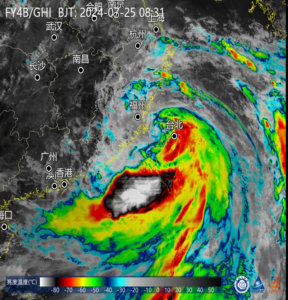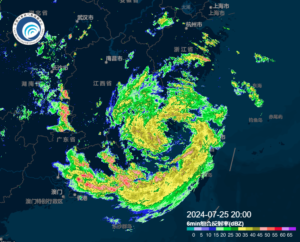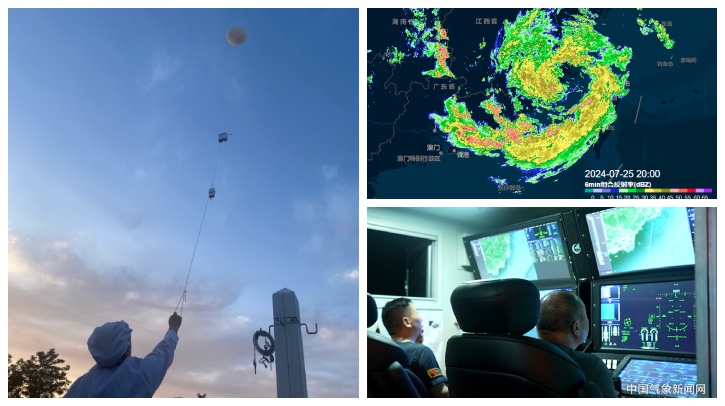To conduct intensive observations of July’s Typhoon Gaemi and Typhoon Prapiroon, the China Meteorological Administration (CMA) activated the Fengyun-4B satellite for the first time, alongside launching the L-band sounding system and deploying large-scale UAVs.
The country’s meteorological departments employed the Fengyun meteorological satellites alongside weather radars, Beidou sounding and large unmanned aerial vehicles (UAV) to perform meteorological disaster prevention and mitigation activities, and carried out coordinated observation experiments of the typhoons.
Fengyun meteorological satellites
The imaging and sounding instruments on board the Fengyun-4B (FY-4B) satellite were activated for the first time to conduct intensive observations and closely monitor typhoon changes as Typhoon Gaemi and Typhoon Prapiroon affected China. These instruments received electromagnetic waves reflected or emitted by typhoon clouds and rain in real time.

Source: NSMC
During the development of Typhoon Gaemi, FY-4B provided convection tracking and water vapor animation, while continuously tracking the movement, direction and intensity of the typhoon. The satellite also provided data support for numerical weather prediction (NWP) assimilation and weather analysis. Through networking observations with the FY-3 meteorological satellites, the internal 3D structure of the typhoon and its entire evolution was captured.
The National Satellite Meteorological Centre (NSMC) also used products such as 3D reflectivity and precipitation rate from the Feng Yun 3G (FY-3G) satellite to monitor Typhoon Gaemi’s development.
Multi-band weather radar networking
While tracking Typhoon Gaemi this year, the Fujian and Jiangxi meteorological departments leveraged a new generation of weather radar and X-band weather radar to conduct networking observation.

Li Lu, an engineer at the CMA’s Meteorological Observation Centre (MOC), said, “The new generation of weather radar could be applied to continuously monitor the overall structural changes of the typhoon in the birth, development and landing process, such as path, intensity and moving speed, but also obtain the refined structure of the convective cell in the typhoon.”

Beidou Round-trip Drifting Sounding System (RDSS)
From July 25 to 26, 2024, at the Fuzhou, Fujian and Hongjia radiosonde stations in Zhejiang province, the Beidou Round-trip Drifting Sounding System (RDSS) was used to obtain multi-stage observation data in the typhoon-affected area, monitoring the development and changes of the typhoon after landing.
On July 1, 2024, China officially launched the L-band sounding system to compare it with the traditional Beidou sounding system. Before this, meteorological departments had only used Beidou sounding technology to monitor severe weather systems, convective conditions and typhoon structures. The parallel and comparative observations of sounding systems were initiated at the national upper-air meteorological observing station in Dalian.
Large scale unmanned aerial vehicle (UAV)
On July 21, 2024, during the influence of Typhoon Prapiroon, China’s Haiyan I UAV dropped sondes, recording the temperature, humidity, wind direction, wind speed, air pressure and other data at different heights, and carried out stereoscopic observation of the 3D structure of the typhoon.
The upper-air large-scale UAVs reached inside the cyclone to obtain direct observation data, forming a comprehensive 3D typhoon monitoring network with meteorological satellites and weather radars. This effort was able to enhance the accuracy of typhoon tracking, intensity, and wind and rain predictions.

Haiyan I UAV was able to detect and obtain high-resolution vertical profiles of wind direction, wind speed, temperature, humidity, pressure and other factors from an altitude of 10,000m, and record the development and evolution of the typhoon.
In related news, the Guangzhou Institute of Tropical and Marine Meteorology (ITMM) and the China Meteorological Administration (CMA) recently launched an observation program in the northern part of the South China Sea. Click here to read the full story.



